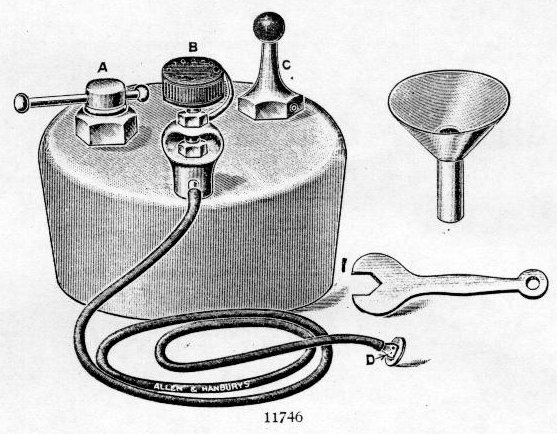The "Bomb" Ether Apparatus.
(a) Ether in a closed space at a temperature of 100°C. is at a pressure of 97 lb. per square inch - its saturation vapour pressure at that temperature. With each fall of temperature there is a corresponding fall of pressure, until at its boiling point ( 35°C.) the effective pressure is nil.
(b) Ether as a liquid expands as the temperature rises, and as liquids are very incompressible, room must be left in the closed space for this expansion. A special filler plug (A) is fitted which ensures that such room is left.
A Safety Blow-off (C) is provided which prevents all possibility of the apparatus bursting.
It is intended for use with ether only.
The ether keeps perfectly well inside the steel container.
Always have the filler-plug (A) screwed up tightly (to prevent leakage
when in use). See that the faces of the filler-plug and container are
quite clean before tightening up.
To Fill.-Unscrew and remove the filler-plug, and pour in ether
until it begins to run over.
If the container is hot, immerse the apparatus in cold water for a
few seconds before unscrewing the filler-plug.
See that the valve is turned off.
Place in a large bowl of boiling water, which may cover it completely.
The valve-top (B) is graduated like a clock dial, the largest red dot
marking the zero or "off" position.
The pointer is set to the zero dot when the valve is shut off, and
is also adjustable, so that it can be reset to this position when the valve has worn a little. This resetting will be seldom needed.
If. the valve gets very loose, tighten the gland-nut, i.e. the little nut
in the middle of the valve.
The spanner provided is for these adjustments.
The small attachment (D) is for the administration of open warm
ether, the method of giving which is described below.

The "bomb" gives a regular flow of warmed vapour which may be directed into lint, into a bag. in conjunction with a gas and oxygen apparatus, with air into the trachea through the nose into the naso-pharynx for dental work, or into the rectum.
Pass the small attachment (D) through two thicknesses of lint and secure with a safety pin. On the frame (e.g. Schimmelbuschís, or a similar type), first place a thin layer of gauze, to prevent dripping or spraying from the orifice of the metal mount, and over this the two thicknesses of lint. Attach the tubing from the bomb to the fitment. Use a face pad beneath the frame.
Place the bomb in a large bowl of boiling water.
To induce, open the valve very slowly, and gradually increase the amount to 15, 20, 25, 30, or even 40 on the dial, according to the patient. It will be found that after the induction appears complete the opening will have to remain at 15 or 20 for some little time (5 or 10 minutes). For maintenance, however, most patients take the valve open at about the 8, 9, or 10 graduations, and no further alteration will be needed until the advent of fresh boiling water.
When the hand can be borne comfortably in the water, pour in fresh boiling water. At the same time shut the valve down to half of what it was (as owing to increased pressure, the patient must not get more vapour).
The various openings of the valve mentioned vary a little in each individual apparatus.
Until well accustomed to using the apparatus, it is better to refill it before every case.